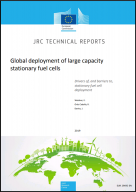Details
- Publication date
- 1 January 2019
- Author
- Joint Research Centre
Description
The long history of stationary fuel cell development and deployment has culminated in a strong growth during the last 10 years. Whether this will lead to full commercialisation independent of governmental incentives, and for which technologies, is as yet uncertain. Stationary fuel cells with capacities >200 kW have been installed in several regions of the world (mainly Europe, Japan, South Korea and the USA), but at widely varying volumes and rates. They can be deployed in the commercial and industrial sectors, to generate power or for cogeneration.
Based on a literature and internet study, information was gathered regarding the installed capacity of the different types of fuel cells and a database was constructed. More than 800MW of large stationary fuel cell systems with a rated power above 200kW have been installed globally for distributed generation and combined heat power applications prior to 2018. The global deployment of large-scale fuel cells is currently dominated by the US and South Korean market, which together make up almost 95% of installed capacity. Within the US, there are major differences in the approach taken at state level, with the majority of the capacity installed in only two states (California and Connecticut).
Worldwide, three technologies dominate: MCFC, SOFC and PAFC. Furthermore, one specialist company dominates the production of each FC type. To understand the drivers of, and barriers to, large-scale capacity fuel cell deployment, technology and policy/regulatory aspects need to be considered, as well as the respective energy system of the country. The study attempts to identify some key factors influencing deployment and to relate them to the trends observed in specific countries/regions. These factors include: energy and climate policies, FC funding programmes, competing technologies, the presence of FC system manufacturers and energy prices (spark spread.
It is clear that considerable financial incentives would be required if the levels of implementation observed in the US and South Korea are to be realised in Europe where companies are currently focussing on small to medium scale applications. However, it should also be considered that there are not the same drivers present in Europe as in South Korea or selected parts of the US, such as high levels of air pollution or an unreliable electricity grid.

